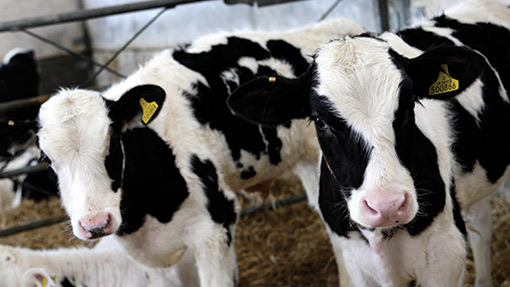Calf management tips to improve cow fertility

Dairy cow fertility across the UK is being severely impacted by farmers’ failure to properly manage calf health and nutrition, a leading scientist has warned.
Claire Wathes, professor of veterinary reproduction at the Royal Veterinary College, said the first weeks of life were vital in the lifetime productivity of cattle, yet few farmers paid enough care and attention to calves.
She said farmer attitudes towards looking after youngstock needed to be overhauled. On average, less than 2% of a dairy farmer’s time was spent looking after calves, yet they were the most important element of their herd’s long-term profitability.
See also: How to prepare your dairy heifers to calve at 24 months
What’s more, farmers often tried to save on costs at the start of a cow’s life, which actually put the herds’ long-term profitability at risk.
“In the UK, 45% of the costs of rearing calves from birth to weaning are in purchasing milk,” she said at the recent British Society of Animal Science international cow fertility conference in Westport, Ireland.
“In a survey of 100 farms, there was a staggering variation in what farmers were giving their calves. We found that some farmers were trying to minimise milk costs by giving calves as little as two litres a day.
“The rationale is that if they can scrimp on milk feeding, they will stagger through to eating concentrates, which is cheaper to feed.”
Tips
- Feed enough to young cows to maximise growth at 0.8kg/day
- Manage weaning and transition well
- Monitor growth rates to check you are on track
- Reduce disease through good housing
The survey found average growth rates for one- to six-month-old calves was 0.77kg/day, but the variations were huge, Prof Wathes said, with the slowest rate at 0.5kg/day while the fastest was 1kg/day.
This growth impacted on the length of time it took for a heifer to reach its first calving and to start becoming profitable through milk production.
“You don’t get payback from a heifer until she reaches her second lactation, so the longer it takes for her to get into calf, the more costly she is to keep,” Prof Wathes said.
To maximise a cow’s lifetime productivity and profitability, heifers should ideally be calved at 24 months, she explained.
Weight gain key
As heifers reached puberty at about 300kg, they needed to grow by 0.8kg/day if they were to be served at 14-15 months in order to reach that 24-month calving target.
Serving them at this age also took advantage of a heifer’s peak conception rate which was reached at 15 months, she said.
“Age at first breeding is a management decision based on size and age, but research has shown you can link development to weight,” she added.
Key points
- The first few weeks of life are vital in lifetime productivity
- On average, calving at 24 months allows a cow to fit in almost one extra lactation during its productive lifetime
- Calving at two years maximises a cow’s profitability and increases lifetime milk production, even if a cow’s first yield is lower than that of later clavers
“Puberty is reached at 40% of mature weight, first breeding at 60% and first calving at 90%.
“Yet only 5% farmers are weighing their young cows, and very few are giving proper thought and time to how they look after them.”
Poor housing and ventilation, and prevalence of disease were also restricting growth rates, with the UK experiencing some of the highest averages of pre-weaning respiratory disease and diarrhoea across Europe.
“When we surveyed UK farmers, we found 48% had diarrhoea and 46% had bovine respiratory disease (BRD) in their pre-weaned cows,” she said. “Those are depressing figures.
“BRD delays the age of first calving by three months and makes them twice as likely not to reach lactation.”
Prof Wathes said taking simple steps to manage disease pre-weaning, including good housing and feeding calves enough to maximise growth, would significantly help improve a cow’s ability to be profitable over its lifetime.
“It is those farmers who skimp on looking after young cows who will pay the penalty in years to come,” she added.
